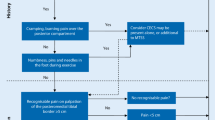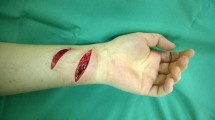Abstract
Combat-related injuries have been well documented for centuries. More recently, injuries suffered by US service members in Iraq and Afghanistan have resulted in a high number of survivable conditions. Polytrauma care in this setting must take into account both the physical and psychological injuries suffered by returning wounded warriors. Catastrophizing may occur when previously healthy individuals are faced with impairment and disfigurement. This is compounded with repeated operative procedures. Early detection and treatment of catastrophizing contributes to improved care of the wounded warrior. This article describes our experiences at Walter Reed Army Medical Center with catastrophizing in US service members returning from the current military operations in Iraq and Afghanistan.
Similar content being viewed by others
References
Papers of particular interest, published recently, have been highlighted as: •• Of major importance
Mitchell S. On the Diseases of Nerves Resulting From Injuries. In: Contributions Relating to the Causation and Prevention of Disease, and to Camp Disease. Flint A, ed. New York: US Sanitation Commission Memoirs; 1867.
Sullivan MJ, Thorn B, Haythornthwaite JA, et al. Theoretical Perspectives on the Relation Between Catastrophizing and Pain. The Clinical Journal of Pain 2001. 17: 52–64.
Weber T, Dragovich A. Offering Hope for Our Wounded Warriors: An Overview of the Womack Army Medical Center Pain Medicine Clinic. The Army Medical Department Journal, Jan./Mar. 2008, p. 45.
Fargo MV, Konitzer LN. Meralgia Paresthetica due to Body Armor Wear in the U.S. Soldiers Serving in Iraq: A Case Report and Review of the Literature. Mil. Med. 2007. 172(6): 663–665.
Lehman C. Mechanisms of Injury in Wartime. Reh. Nursing 2008. 33(5): 192–205.
Sell T, Chu Y, Abt J, et al. Minimal Additional Weight of Combat Equipment Alters Air Assault Soldiers’ Landing Biomechanics. Mil. Med. 2010. 175(1): 41–47.
Cohen SP, Griffith S, Larkin TM, et al. Presentation, Diagnosis, Mechanisms of Injury, and Treatment of Soldiers Injured in Operation Iraqi Freedom: An Epidemiological Study Conducted at Two Military Pain Management Centers. Anesthesia Analgesia 2005. 101: 1098
van den Oord MHAH, De Loose V, Meeuwsen T, et al. Neck Pain in Military Helicopter Pilots: Prevalence and Associated Factors. Mil. Med. 2010. 175(6): 55–60.
Smith TC, Zamorski M, Smith B, et al. The Physical and Mental Health of a Large Military Cohort: Baseline Functional Health Status of the Millennium Cohort. BMC Public Health 2007. 7: 340.
Milliken CS, Auchterlonie JL, Hoge CW. Longitudinal Assessment of Mental Health Problems Among Active and Reserve Component Soldiers Returning from the Iraq War. JAMA 2007. 298(18): 2141–2148.
•• Melcer T, Walker GJ, Galarneau M, et al. Midterm Health and Personnel Outcomes of Recent Combat Amputees. Mil. Med. 2010. 175(3): 147–154. This study suggests that two thirds of combat amputees had a mental health disorder, supporting the need for military amputee care programs.
Bray RM, Pemberton MR, Lane ME. Substance use and mental health trends among U.S. military active duty personnel: key findings from the 2008 DoD Health Behavior Survey. Mil. Med. 2010. 175(6): 390–9.
Weber NS, Cowan DN, Bedno SA, et al. Descriptive epidemiology of bipolar I disorder among United States military personnel. Mil. Med. 2010. 175 (4): 247–51.
•• Goldberg MS. Death and Injury Rates of U.S. Military Personnel in Iraq. Mil. Med. 2010. 175(4): 220–26. This study looked at casualty rates during the “surge” in Iraq and provides a comprehensive overview of the sustained injuries.
Belmont PJ, Goodman GP, Waterman B, et al. Disease and nonbattle injuries sustained by a U.S. Army Brigade Combat Team during Operation Iraqi Freedom. Mil. Med. 2010. 175(7): 469–76.
Belmont PJ, Goodman GP, Zacchilli M, et al. Incidence and epidemiology of combat injuries sustained during “the surge” portion of operation Iraqi Freedom by a U.S. Army brigade combat team. The Journal of Trauma-Injury Infection & Critical Care. 2010. 68(1): 204–10.
Wojcik BE, Akhtar FZ, Hassell LH. Hospital admissions related to mental disorders in U.S. Army soldiers in Iraq and Afghanistan. Mil. Med. 2009. 174(10): 1010–18.
Larson GE, Booth-Kewley S, Highfill-McRoy RM, et al. Prospective analysis of psychiatric risk factors in marines sent to war. Mil. Med. 2009. 174(7): 737–44.
Sullivan MJL, Bishop SR, Pivik J. The Pain Catastrophizing Scale: Development and Validation. Psychological Assessment. 7(4): 524-532
Edwards RR, Goble L, Kwan A. Catastrophizing, pain, and social adjustment in scleroderma: relationships with educational level. Clinical Journal of Pain 2006. 22(7): 639–46.
Roth RS, Geisser ME. Educational achievement and chronic pain disability: mediating role of pain-related cognitions. Clinical Journal of Pain 2002. 18(5): 286–96.
Lautenbacher S, Huber C, Kunz M, et al. Hypervigilance as predictor of postoperative acute pain: its predictive potency compared with experimental pain sensitivity, cortisol reactivity, and affective state. Clinical Journal of Pain 2009. 25(2): 92–100.
Tang NK, Salkovskis PM, Hanna M. Mental defeat in chronic pain: initial exploration of the concept. Clinical Journal of Pain 2007. 23(3): 222–32.
Pavlin DJ, Sullivan MJ, Freund PR, et al. Catastrophizing: a risk factor for postsurgical pain. Clinical Journal of Pain 2005. 21(1): 83–90.
Granot M, Ferber SG. The roles of pain catastrophizing and anxiety in the prediction of postoperative pain intensity: a prospective study. Clinical Journal of Pain 2005. 21(5): 439–45.
Bachiocco V, Morselli AM, Carli G. Self-control expectancy and postsurgical pain: relationships to previous pain, behavior in past pain, familial pain tolerance models, and personality. Journal of Pain & Symptom Management 1993. 8(4): 205–14.
Sommer M, de Rijke JM, van Kleef M, et al. Predictors of acute postoperative pain after elective surgery. Clinical Journal of Pain 2010. 26(2): 87–94.
Severeijns R, Vlaeyen JW, van den Hout MA, et al. Pain catastrophizing predicts pain intensity, disability, and psychological distress independent of the level of physical impairment. Clinical Journal of Pain 2001. 17(2): 165–72.
Wollaars MM, Post MW, van Asbeck FW, et al. Spinal cord injury pain: the influence of psychologic factors and impact on quality of life. Clinical Journal of Pain 2007. 23(5): 383–91.
•• Ciccone DS, Chandler HK, Kline A. Catastrophic appraisal of acute and chronic pain in a population sample of new jersey national guard troops. Clinical Journal of Pain 2010. 26(8): 712–21. This study provides an excellent analysis of catastrophic behavior in predeployed troops from a National Guard unit.
Hill A, Niven CA, Knussen C. The Role of Coping in Adjustment to Phantom Limb Pain. Pain 1995. 62(1): 79–86.
Merlijn VP, Hunfeld JA, van der Wouden JC, et al. Factors related to the quality of life in adolescents with chronic pain. Clinical Journal of Pain 2006. 22(3): 306–15.
Smeeding SJ, Bradshaw DH, Kumpfer KL, et al. Outcome Evaluation of the Veterans Affairs Salt Lake City Integrative Health Clinic for Chronic Nonmalignant Pain. Clinical Journal of Pain 2010. Sep. 8. [Epub ahead of print]
Disclosures
No potential conflicts of interest relevant to this article were reported.
Author information
Authors and Affiliations
Corresponding author
Rights and permissions
About this article
Cite this article
Spevak, C., Buckenmaier, C. Catastrophizing and Pain in Military Personnel. Curr Pain Headache Rep 15, 124–128 (2011). https://doi.org/10.1007/s11916-011-0173-7
Published:
Issue Date:
DOI: https://doi.org/10.1007/s11916-011-0173-7




